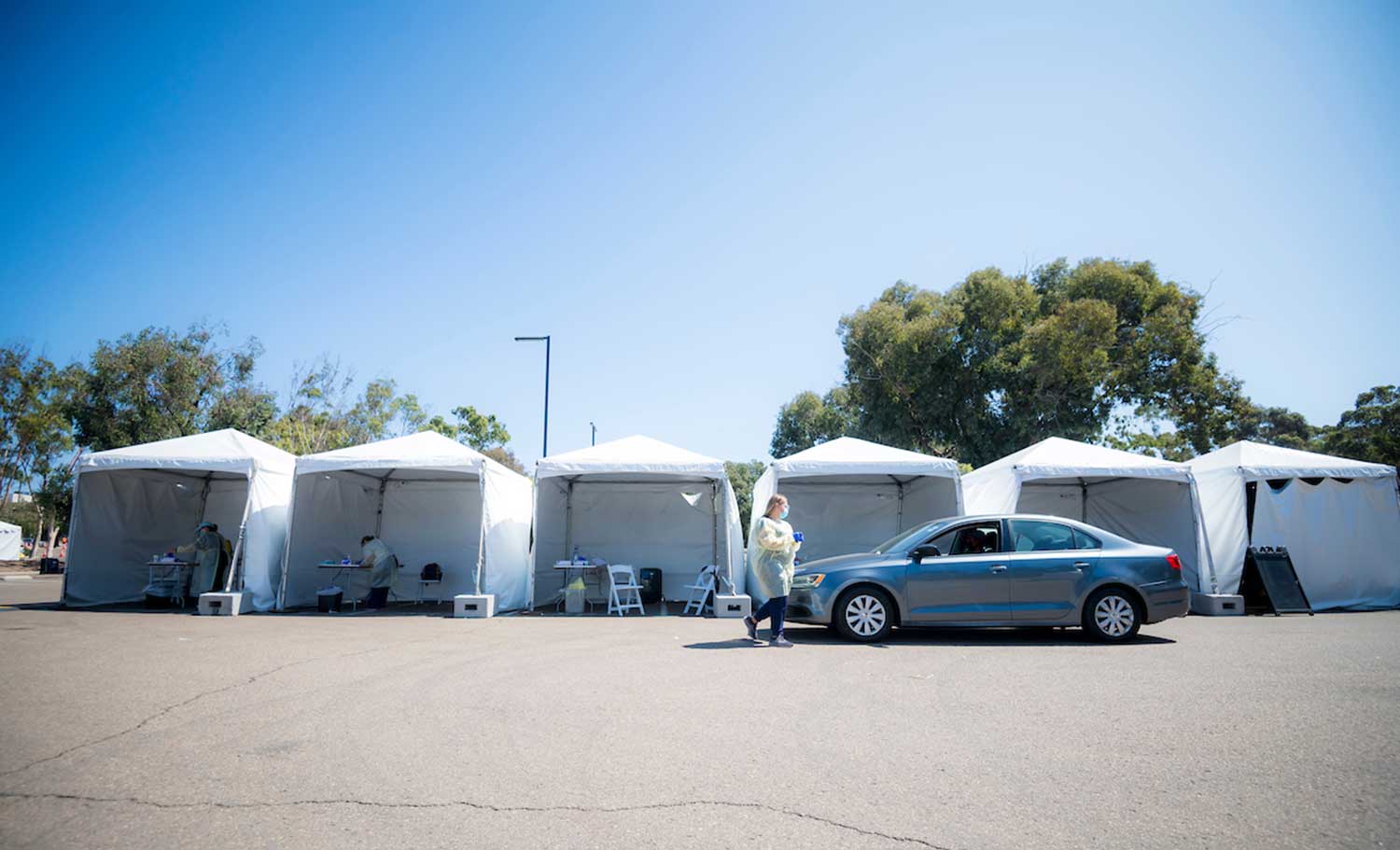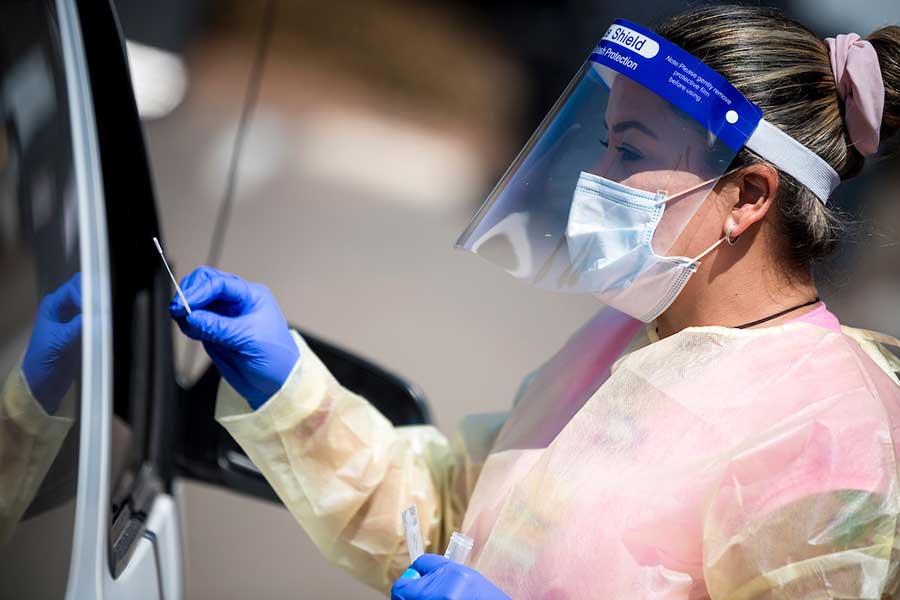By:
- Erika Johnson
Published Date
By:
- Erika Johnson
Share This:

Q&A: How Often Are Asymptomatic Tests Needed?

UC San Diego’s fall plan continues to evolve, informed by the university’s Return to Learn program. We invited students, faculty and staff to submit their questions about testing, including how frequently asymptomatic testing is recommended, how soon to get tested after potential exposure, what sensations might arise during the test and what to expect at a drive-up testing site. To learn more, we spoke with Dr. Angela Scioscia, interim executive director for Student Health and Wellness.
Q. How long does it take for symptoms to appear after exposure?
A. Some individuals will never have symptoms. The average time for an individual to start shedding virus (when the virus replicates inside your body and is released into the environment) is about five days after exposure. Both virus shedding and symptoms can appear as early as two days after exposure and can be extended up to a period of 14 days. This is why we tell individuals who have been exposed that they are at risk for shedding the virus either with or without symptoms for up to 14 days.
Q. If you think you may have been exposed, how soon should you get tested?
A. If you think you may have been exposed, you should quarantine for a period of 14 days from the date of exposure. This means you will stay within your household and not leave except for medical care. We recommend you have a SARS-CoV-2 test five days after exposure, whether you have symptoms or not. If you receive a positive result, you need to take additional precautions to avoid exposing others. You need to isolate, stay within one bedroom and use a private bathroom (or disinfect the bathroom upon each use).
If your test from day five is negative, you will still need to remain in quarantine for the entire 14-day period, since you may start shedding virus at a later date. For individuals in quarantine, extra precautions should be taken for those living with vulnerable individuals who have underlying medical conditions, as they can be more severely impacted by the virus. Learn more on the Testing and Screening page here.
Q. How often do you recommend asymptomatic testing?
A. We are encouraging faculty and staff to take advantage of voluntary testing. We recommend twice monthly, at least every 12 days with no more than 16 days between tests. If at any time you develop symptoms, then you will need additional testing. On-campus and remote employees can schedule their asymptomatic test here. All undergraduate and graduate students coming to campus, including all students living in university-owned housing, are required to participate in asymptomatic testing at least every 12 days with no more than 16 days between tests.
If you are tested at a UC San Diego Health location and your result is positive, a healthcare professional will call you with your test results, usually within 24 hours. If your test results are negative, you will receive a notification in your MyChart account (an access code to sign up for MyChart will be sent to you in the appointment confirmation email). If you do not have a MyChart account, you will receive a phone call to convey your test results, regardless of positive or negative results.

Q. What does the nasal swab measure and why is it effective?
A. When we sample inside the nose, we are picking up the actual RNA virus through a very sensitive assay, or laboratory test. We’re exploring a variety of techniques that are accurate in identifying the virus. We also want to offer testing that is easy for the individual to experience, or even self-administer, which will make it a simpler process. Samples are processed at the Center for Advanced Laboratory Medicine (CALM) at UC San Diego Health as well as the Expedited Covid IdenTification Environment (EXCITE) laboratory on campus.
Q. What can faculty, staff and students expect at a drive-up or walk-in testing site?
A. There are six drive-up and walk-in testing locations available, both on campus and in the community. All sites are by appointment only to enable us to achieve appropriate social distancing.
Your first step will be to check in. The provider will ask for your identification and verify that your order has been placed with the laboratory. At the next station, a UC San Diego Health provider will conduct the sampling. They will place a swab in your nose for a few seconds, then you will be on your way. Results are returned within 24 hours; some individuals have received them on the same day.
Q. Is there a limit to the number of tests someone can get?
A. We are not putting strict limits on the testing. We are asking individuals to be responsible and realize that this is a limited and valuable resource. Moreover, daily testing has no benefit. We encourage testing if you have symptoms, believe you may have been exposed, or are following the recommended twice monthly asymptomatic testing regime.
Also, if we sense that there is an increase in viral activity in a part of our community, we may ask individuals to undergo extra testing. For instance, when we identified active virus in campus wastewater over Labor Day weekend, targeted messages were sent to those who might have been impacted indicating they should be tested for the virus as soon as possible.
Q. What advice would you offer those who may be hesitant to get tested?
A. We have to confront this virus as a community. That means taking part in preventative measures, such as regular asymptomatic testing, so that we may slowly get back to a more normal life. In the beginning, some were concerned that the test would be painful. However, this anxiety is dissipating as more take part. It’s a very short, temporary discomfort. And everyone experiences it differently. The important part is that the test is over very quickly.
Q. Why is the daily symptom screening necessary?
A. Completing the daily symptom screening is a good habit to get into. It’s also the easiest way to access a test if symptoms appear, as well as get a quick result. It is a great way to check your status and remind yourself of the symptoms to watch for. If some of the symptoms resonate, then stay put and schedule a test. I would encourage everyone in our community to take advantage of our daily screening and all the clinical care that comes from that process.
Have more questions? We invite the campus community to submit your inquiries online. A new Q&A with a Return to Learn expert will be published each Thursday in “This Week @ UC San Diego” for the next several weeks.
Share This:
You May Also Like
Stay in the Know
Keep up with all the latest from UC San Diego. Subscribe to the newsletter today.



